Homosexuality is like suicide. In the literary sense, I mean. Think about it. If you are reading a novel or short story and the main character just happens to off himself without foreshadowing, reason, or resultant purpose then it can safely be assumed that what you are reading is not very good. This is the case with the short story “Toughest Indian in the World,” except substitute homosexuality for suicide and you get the idea. Lisa Tatonetti claims that homosexuality is a useful literary tool for illustrating character development, and I could not agree more. I just happen to disagree with her argument that Sherman Alexie is any good at using that tool (specifically in his short story “Toughest Indian in the World”). However, in contemporary analysis of the use of “controversial” themes such as homosexuality, critics like Tatonetti and Julie Bolt - and Alexie himself - dare you to criticize the work. Bolt, and Alexie, assert that if you criticize it then you are a homophobe. I assert that the problem is not with the homosexuality, it is how it is used; poorly, cheaply, etc. So I will criticize, not because I am a homophobe, but because if I do not criticize, then I am fearfully endorsing awful literature.
Tatonetti posits that homosexuality - amongst other “queer” identities - have suffered in literature, especially Native American literature; “…critical investigations of this important body of literature are just now finding representation in scholarly forums on American Indian literature” (Tatonetti 35.2). Her brief analysis of recent queer Native American texts successfully illustrates how the “Toughest Indian” might come to be championed by those who wish to find important and significant queer identities in Native American literature. She then posits that homosexual identities are good vehicles to explore character transformation, and to this I agree. She also concludes that Sherman Alexie’s homosexuality constructs in “Toughest Indian” are productive and successful ones; “I argue that the narrator's queer relationship to the fighter is situated as an avenue of transformation” (Tatonetti 35.2) While I can endorse her initial positions, I cannot disagree more with her conclusion. Her intention with this last quote is to argue that the homosexuality in “Toughest Indian” was used productively, however her reasons she offers in support of this claim mainly are derivatives of her first quote decrying the lack of queer identities.
Inhaltsverzeichnis (Table of Contents)
- The Preemptive Straw Man
- Homosexuality: A Literary Tool
- A Controversial Subject
- The Importance of Foreshadowing
- The Problem with Alexie's Use of Homosexuality
- The Role of the Hitchhiker
- The Importance of Context
- The Significance of Salmon
- Alexie's Failure to Connect
- A Lack of Nuance
Zielsetzung und Themenschwerpunkte (Objectives and Key Themes)
This essay analyzes Sherman Alexie’s short story “The Toughest Indian in the World” and critiques its use of homosexuality as a literary device. The author argues that Alexie's portrayal of homosexuality is poorly constructed and lacks the necessary foreshadowing and context for a meaningful exploration of the character's transformation.
- The use of homosexuality as a literary device in fiction
- The importance of foreshadowing and character development in short stories
- Critical analysis of Sherman Alexie's writing style and themes in “The Toughest Indian in the World”
- The controversy surrounding the portrayal of homosexuality in literature
- The potential pitfalls of using "controversial" subjects in fiction
Zusammenfassung der Kapitel (Chapter Summaries)
- The Preemptive Straw Man: The author introduces the main argument of the essay, criticizing Alexie's use of homosexuality in "The Toughest Indian in the World" as a cheap and poorly constructed literary device.
- Homosexuality: A Literary Tool: The author explores the potential of homosexuality as a tool for character development in literature but argues that Alexie fails to utilize it effectively.
- A Controversial Subject: The author discusses the complexities of portraying homosexuality in fiction and the challenges of navigating political correctness surrounding this sensitive topic.
- The Importance of Foreshadowing: The author emphasizes the need for foreshadowing and context when utilizing complex themes such as homosexuality in literature.
- The Problem with Alexie's Use of Homosexuality: The author analyzes specific instances from the story to illustrate the lack of foreshadowing and the contrived nature of the homosexual encounter.
- The Role of the Hitchhiker: The author examines the portrayal of the hitchhiker character and its connection to the main theme of Native American identity.
- The Importance of Context: The author underscores the significance of providing a comprehensive background and rationale for the character's transformation.
- The Significance of Salmon: The author analyzes the symbolic use of salmon in the story and how it fails to effectively contribute to the character's development.
- Alexie's Failure to Connect: The author critiques Alexie's attempts to silence criticism by accusing dissenting readers of being homophobic and narrow-minded.
- A Lack of Nuance: The author concludes that Alexie fails to present a nuanced and intellectually engaging exploration of homosexuality in his short story.
Schlüsselwörter (Keywords)
This essay focuses on key concepts such as homosexuality in literature, character development, foreshadowing, controversial themes, literary criticism, Native American identity, and the use of symbolism in fiction. The analysis explores the potential pitfalls of using "controversial" subjects in fiction and criticizes Sherman Alexie's portrayal of homosexuality in his short story "The Toughest Indian in the World."
- Quote paper
- Michael Knabel (Author), 2010, The Preemptive Straw Man - A Critique of Sherman Alexie's "Toughest Indian in the World"., Munich, GRIN Verlag, https://www.hausarbeiten.de/document/153077


